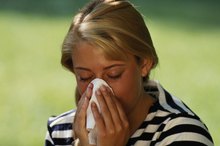Down Pillow Allergy Symptoms
The most common signs of an allergy to down pillows mimic those of hay fever. Itching and breathing problems occur when patients ingest the allergens in down and other bird feathers. These bird products break down over time, until tiny particles become airborne, which can then be inhaled. Feather allergies usually indicate sensitivities to allergenic proteins in birds. Alternatively, people can develop allergy symptoms to molds and dust mites that feed on feathers. Medical testing can distinguish among these sources, which produce the same symptoms in allergy patients.
If you are experiencing serious medical symptoms, seek emergency treatment immediately.
Nose and Throat
In people with feather allergies, exposure to down pillows and other bird products sends histamines racing through the bloodstream to neutralize the allergens. Side effects of this inflammatory response include itching as well as fluid buildup in the mucous membranes. According to the University of Maryland (UM) Medical Center, respiratory symptoms of perennial allergic rhinitis include:
- sneezing
- runny nose
- sinus congestion
- coughing
- sore throat 1
Postnasal drip may drain excess mucus into the pharynx, where patients swallow it. The nose, mouth and throat may become itchy and inflamed.
- In people with feather allergies, exposure to down pillows and other bird products sends histamines racing through the bloodstream to neutralize the allergens.
- According to the University of Maryland (UM) Medical Center, respiratory symptoms of perennial allergic rhinitis include: * sneezing
* runny nose
* sinus congestion
* coughing
* sore throat 1 Postnasal drip may drain excess mucus into the pharynx, where patients swallow it.
Eye
Detergent Allergy Symptoms
Learn More
Similar effects occur in the eyes during an allergic reaction to down pillows. This set of symptoms, termed allergic conjunctivitis, affects the eyes and surrounding tissue 2. Inflammation can create intense eye itching and redness. The Cleveland Clinic reports that fluid migration into the conjunctiva, or mucous membranes of the eyes, creates allergy symptoms of heavy tears that may form crusts 2. Inflamed tissue can swell, leaving puffy eyelids or dark undereye circles.
Skin
People with feather allergies can get skin symptoms from handling birds or bird droppings, or from contact with down pillows and down-filled clothing. Feathers can easily escape from many cloth coverings and directly touch the skin. This can result in allergic contact dermatitis, another inflammatory condition caused by histamines. The UM Medical Center reports that contact dermatitis generates skin itching, redness, dryness and raised bumps 1. Extreme cases may develop blisters that drain fluid.
- People with feather allergies can get skin symptoms from handling birds or bird droppings, or from contact with down pillows and down-filled clothing.
Complications
Oak Pollen Allergy Symptoms
Learn More
Individuals with feather allergies who also have asthma may experience complications of normal allergy symptoms. The feather allergens in pillows, comforters and clothing can trigger mild to severe asthma attacks. Allergic inflammation then extends to the bronchial tubes and lungs, causing coughing, wheezing and trouble breathing. Inhaled asthma medication can reverse this condition. Patients can also control regular down allergy symptoms by taking antihistamines and nasal steroids in the short term, and by ending their exposure to feather pillows in the long term.
- Individuals with feather allergies who also have asthma may experience complications of normal allergy symptoms.
- Patients can also control regular down allergy symptoms by taking antihistamines and nasal steroids in the short term, and by ending their exposure to feather pillows in the long term.
Related Articles
References
- UM Medical Center: Allergic Rhinitis
- Cleveland Clinic: Conjunctivitis
- American Academy of Allergy Asthma & Immunology. Allergic Reactions.
- Kołodziejczyk K, Bozek A. Clinical Distinctness of Allergic Rhinitis in Patients with Allergy to Molds. Biomed Res Int. 2016;2016:3171594. doi:10.1155/2016/3171594
- American Academy of Allergy Asthma & Immunology. All About Allergy Testing.
- Bernstein IL, Li JT, Bernstein DI, et al. Allergy Diagnostic Testing: An Updated Practice Parameter. Ann Allergy Asthma Immunol. 2008;100(3 Suppl 3):S1-148. (Current as of Sept. 2019). doi:10.1016/S1081-1206(10)60305-5
- Carr S, Chan E, Lavine E, Moote W. CSACI Position Statement on the Testing of Food-Specific IgG. Allergy Asthma Clin Immunol. 2012;8(1):12. Published 2012 Jul 26. doi:10.1186/1710-1492-8-12
- Fonacier L, Bernstein DI, Pacheco K, et al. Contact Dermatitis: A Practice Parameter-Update 2015. J Allergy Clin Immunol Pract. 2015;3(3 Suppl):S1-39. doi:10.1016/j.jaip.2015.02.009
Writer Bio
Nancy Clarke began writing in 1988 after achieving her Bachelor of Arts in English and has edited books on medicine, diet, senior care and other health topics. Her related affiliations include work for the American Medical Association and Oregon Health Plan.









